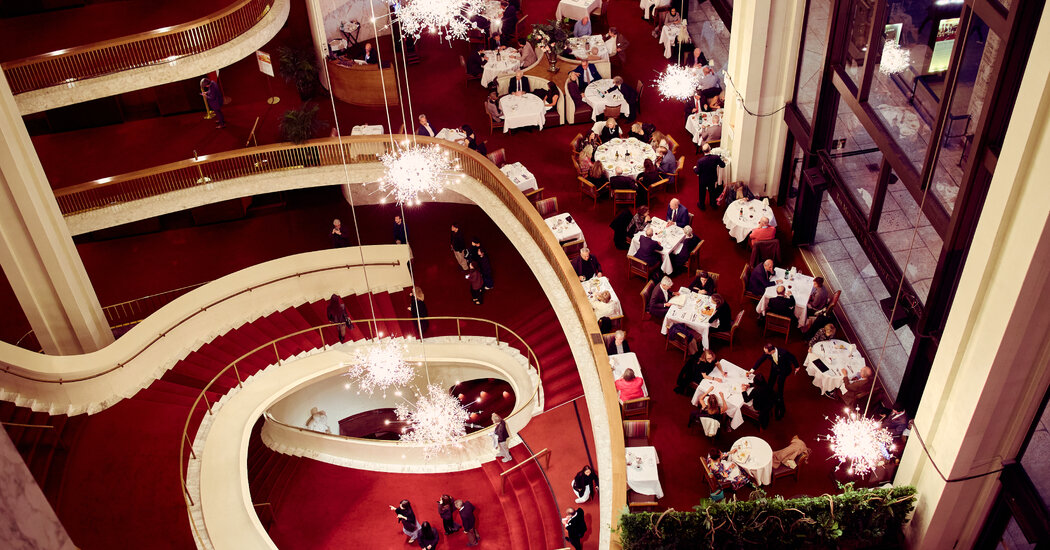Opera is an art form that favors extravagant appetites. For every dining-obsessed Don Giovanni, Falstaff or Alfredo, there’s an opera-inspired dish of peach Melba, tournedos Rossini or pasta alla Norma.
But the marriage of music and cuisine is nowhere more evident than at the Metropolitan Opera House in New York City, where feeding about 3,800 audience members and 3,000 employees each performance is itself a production of operatic proportions.
At the center of it all is the Grand Tier Restaurant. Service starts two hours before curtain, though if you’re not among the 150 diners with a reservation, prime time might be at intermission. That’s when you can prop yourself against a rail on the balcony or dress circle and peer down through sparkly chandeliers into this rarefied habitat, with its plumes of flowers and 36-foot Chagalls, to observe a shimmering pageant of lavishly dressed patrons glide to their places, already set with silver domes.
It can feel like gazing into an aquarium of colorful sea creatures. Although you don’t need a ticket to eat there (it’s open to anyone before shows start), most Grand Tier diners are subscribers and donors who return to the same tables season after season. With opera glasses in hand, you might just make out their smoked salmon with neat pumpernickel crisps, as well as those immortal golden crab cakes — the two most popular items on the prix-fixe menu, whose three courses cost $118.
Restaurants in opera houses around the world date back to at least the 19th century. In 1966, when the Met relocated to Lincoln Center from its original home on Broadway, the architects reserved generous square footage for eating and drinking. The new building would have two sit-down restaurants, a moderately priced cafeteria for staff members and their guests, and a half-dozen bars scattered throughout.
It is still the largest opera house in the world, though there have been a few tweaks over the years. The Top of the Met restaurant, once perched on the sixth floor overlooking the majestic lobby and the plaza fountain, closed in the 1970s, and the space was converted into a warren of administrative offices and kitchen prep rooms.
But the original Grand Tier restaurant and the intermission bars continue to flourish, to the tune of about 400 glasses of Champagne and sparkling wine clinked per performance.
All food service is handled by the Patina Group, which also runs culinary operations for the Walt Disney Company and the P.G.A. Yet the Met poses a unique challenge because of the sheer diversity of the populations it feeds.
As Florian Wehrli, who recently served three seasons as executive chef at the Grand Tier, told me, “We don’t just cater to rich and famous people. We also cater to the stagehands, the seamstresses, the cleaning crew, the office workers, the singers and dancers and musicians. All of these groups want different things, and we need to feed them all.”
I spent a night at the opera during a recent performance of “Turandot” to see how they do it.
The Dining Room Show
Two things at the Met will never go away, as Peter Gelb, its general manager, reassured me: Franco Zeffirelli’s lavish 1981 production of “La Bohème,” and the crab cakes at the Grand Tier Restaurant.
“For many Met attendees, getting dressed up and dining before the performance or during intermissions is an essential part of going to the opera,” Mr. Gelb wrote in an email. “And a sated audience is seemingly more attuned to our performances as long as they don’t drink too many glasses of Champagne.”
After working the floor for 30 years, Jerry Duque, a captain known as J.D., understands this delicate balance. “They want a good meal, but nothing heavy,” he said. “They don’t want to fall asleep.” He jokes with customers that dozing at the opera is “the most expensive nap in New York City.”
In the kitchen, the carpeted hush of the dining room gives way to the metallic bang of tongs on pans, the slam of oven doors, the hiss of meats meeting fire, the nonstop click-click-click of the printer spitting out order tickets in a long cascade. Parcooked lobster, seared chicken and salmon shingled with potatoes are lined up in pans.
Because all guests sit down to dinner at about the same time, the team needs to cook and serve 150 appetizers and main courses in under an hour. It’s a highly choreographed endeavor that tolerates no mistakes. One overcooked beef tenderloin can throw a wrench into the flow.
At about 15 minutes before showtime, chimes summon the audience to their seats. The gorgeous wave of diners flows in reverse, back out of the restaurant, onto the stairs and into their seats.
The Intermission Bite
Since the Grand Tier accommodates only about 5 percent of the audience, the other 95 percent heads to the intermission bars, forming long lines that can rival the ladies’-room queue. Even so, an intermission that’s long enough for sit-down crab cakes is generally long enough for the wait and a snack standing up.
Although the bars offer sandwiches and chocolates, most people come for the drinks. The $26 espresso martini, a fairly recent addition to the cocktail menu, may be the perfect opera apéro — a trifecta of buzzes from sugar, alcohol and coffee. The bars sell about 150 every night.
For operagoers who haven’t eaten, or for performances that run long enough to necessitate a mid-show snack (Wagnerians will know what I’m talking about), there are sandwiches like smoked salmon on black bread, and ham and Brie on brioche. Those sandwiches have been on the menu for at least the 26 years that the prep cook Angel Ramirez has been making them. A self-described sandwich maestro, Mr. Ramirez spends six to eight hours every day in a small prep room, assembling about 250 sandwiches.
Crowds at the intermission bars vary wildly, but one rule holds true: The longer the opera, the hungrier and thirstier the patrons become. “By the second intermission,” one staff member noted, “people line up for the chocolates.”
Chocolate features big during intermissions at the Grand Tier Restaurant, too, where diners who didn’t finish their meals before the show can return for dessert. Those in the know pre-order chocolate soufflés, which aren’t on the menu because the kitchen has the oven space to bake only 30 per night. The soufflés arrive en masse, carried by servers on round silver trays, the scent of cocoa wafting behind them as they quickly stride across the dining room.
The Subterranean Staff Cafeteria
While the audience snacks and sips under the bright lights upstairs, there’s yet another culinary world below the stage. To get to the staff cafeteria, you walk down several long, narrow corridors, past a stray fortepiano, to a low-ceilinged, dimly lit room decorated with an abundance of hard-to-kill plants. It’s about the same walking distance from the Grand Tier Restaurant as from Valhalla to Nibelheim. Met employees can have breakfast or lunch here, and cast members often grab a bite between scenes.
During the first intermission of a recent “Turandot” performance, a couple of villagers from ancient China — actually chorus members in full costume — sat eating clam chowder.
As for the cafeteria’s limited offerings (a salad bar, soups, sandwiches and a steam table), they were resigned. “Where else are you going to go?” one villager, who declined to give his name, said with a shrug. “Even the deli is too far. And technically we’re not allowed to leave the theater in our costumes during intermission. I mean, people do it, but it’s not allowed.”
Nearby, I found Michael Fabiano noshing on potato chips, in leather vest and leggings for his leading role as Calaf. Next to him sat his voice teacher, the tenor Neil Shicoff, who had gotten himself some braised chicken and mashed potatoes from the steam table.
Mr. Shicoff eyed his student’s chips. “How can you sing after that?” he chided. The veteran singer gestured at his chicken: “Now that’s the kind of thing a singer should eat during intermission.”
Mr. Fabiano grinned and washed the chips down with a Dr Pepper. Then he walked upstairs to deliver his “Nessun Dorma,” with an exquisitely well-salted high B.
Follow New York Times Cooking on Instagram, Facebook, YouTube, TikTok and Pinterest. Get regular updates from New York Times Cooking, with recipe suggestions, cooking tips and shopping advice.
Melissa Clark has been writing her column, A Good Appetite, for The Times’s Food section since 2007. She creates recipes for New York Times Cooking, makes videos and reports on food trends. She is the author of 45 cookbooks, and counting.
The post How the Metropolitan Opera Feeds Its Over-the-Top Appetites appeared first on New York Times.




